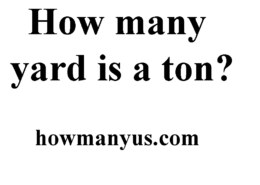How many yard is a ton?
The question “How many yards is a ton?” explores the conversion between weight (ton) and volume (yard) for various materials. This inquiry is important in industries such as construction, landscaping, and agriculture, where understanding material quantities is crucial for project planning and execution.
To determine how many yards are equivalent to a ton, it’s essential to consider the density or specific gravity of the material being measured. Different materials have different densities, which affect their volume-to-weight ratios.
For example, the conversion of tons to yards for materials like soil, gravel, or sand depends on their density. Lighter materials occupy more volume per ton, while denser materials occupy less volume per ton.
How many yard is a ton?
Understanding the relationship between tons and yards allows professionals and enthusiasts to estimate material requirements accurately, optimize resource utilization, and ensure project efficiency.


The question “How many yards is a ton?” delves into the conversion between weight (ton) and volume (yard) for various materials. This conversion is essential in industries such as construction, landscaping, and agriculture, where accurate estimation of material quantities is critical for project planning and execution.
Understanding Tons and Yards:
Tons (often measured as a short ton or metric ton) represent a unit of weight, while yards denote a unit of volume. Converting tons to yards requires knowledge of the density or specific gravity of the material in question.
Factors Affecting Conversion:
The conversion of tons to yards depends on the density of the material being measured. Different materials have varying densities, which impact their volume-to-weight ratios:
Conversion Formula:
To convert tons to yards, use the following formula:
Volume (yards)=Density (tons per cubic yard)Weight (tons)
Practical Examples:
Volume (yards)=1.25 tons per cubic yard1 ton=0.8 cubic yards
Volume (yards)=0.75 tons per cubic yard1 ton=1.33 cubic yards
Importance of Conversion:
Accurate conversion between tons and yards is crucial for various applications:
Tips for Conversion:
Conclusion:
In conclusion, understanding how many yards are in a ton is essential for professionals and enthusiasts in industries such as construction, landscaping, and agriculture. By knowing the density of materials and applying conversion formulas, individuals can estimate material quantities accurately, optimize resource utilization, and ensure project efficiency. Whether it’s calculating gravel for a driveway or topsoil for a garden, mastering the conversion between tons and yards facilitates effective project planning and execution. Stay informed, utilize conversion tools, and leverage material density data to make informed decisions and achieve optimal results in various applications.